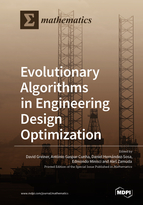Evolutionary Algorithms in Engineering Design Optimization
A special issue of Mathematics (ISSN 2227-7390). This special issue belongs to the section "Engineering Mathematics".
Deadline for manuscript submissions: closed (30 June 2021) | Viewed by 30965
Special Issue Editors
Interests: structural optimization; design optimization; multi-objective optimization; evolutionary algorithms; computational mechanics
Interests: multi-objective optimization; multidisciplinary optimization; decision making; robustness of the solutions; engineering optimization
Interests: autonomous robotics; autonomous underwater vehicles; multi-objective optimization; evolutionary algorithms for path-planning and obstacle avoidance
Interests: multidisciplinary design optimization; optimization under uncertainty; nature inspired algorithms; engineering optimization; aerospace engineering; surrogate based optimization
Interests: differential evolution; multiobjective optimization; evolutionary robotics; artificial life; cloud computing
Special Issues, Collections and Topics in MDPI journals
Special Issue Information
Dear Colleagues,
Evolutionary algorithms (EAs) are population-based global optimizers, which, due to their characteristics, allowed to solve, in a straightforward way, many real world optimization problems in the last three decades, particularly in engineering fields. Their main advantages are comprised of the following: they do not require any requisite to the objective/fitness evaluation function (e.g., continuity, derivability, convexity, etc.); they are not limited by the appearance of discrete and/or mixed variables or by the requirement of uncertainty quantification in the search. Moreover, they can deal with more than one objective function simultaneously through the use of evolutionary multi-objective optimization algorithms. This set of advantages, and the continuously increased computing capability of modern computers, has enhanced their application in research and industry.
From the application point of view, in this Special Issue proposal, all engineering fields are welcomed, such as aerospace and aeronautical, biomedical, chemical and materials science, civil, electronic and telecommunications, energy and electrical, manufacturing, logistics and transportation, mechanical, naval architecture, reliability, robotics, structural, etc.
Within the EA field, the integration of innovative and improvement aspects in the algorithms (e.g., genetic algorithms, differential evolution, evolution strategies, etc.) for solving real world engineering design problems, in the abovementioned application fields, are welcomed and encouraged, such as the following: parallel EAs, surrogate modeling, hybridization with other optimization techniques, multi-objective and many-objective optimization, etc.
Assoc. Prof. Dr. David Greiner
Prof. Dr. António Gaspar‐Cunha
Assoc. Prof. Dr. Daniel Hernández-Sosa
Assoc. Prof. Dr. Edmondo Minisci
Assoc. Prof. Dr. Aleš Zamuda
Guest Editors
Manuscript Submission Information
Manuscripts should be submitted online at www.mdpi.com by registering and logging in to this website. Once you are registered, click here to go to the submission form. Manuscripts can be submitted until the deadline. All submissions that pass pre-check are peer-reviewed. Accepted papers will be published continuously in the journal (as soon as accepted) and will be listed together on the special issue website. Research articles, review articles as well as short communications are invited. For planned papers, a title and short abstract (about 100 words) can be sent to the Editorial Office for announcement on this website.
Submitted manuscripts should not have been published previously, nor be under consideration for publication elsewhere (except conference proceedings papers). All manuscripts are thoroughly refereed through a single-blind peer-review process. A guide for authors and other relevant information for submission of manuscripts is available on the Instructions for Authors page. Mathematics is an international peer-reviewed open access semimonthly journal published by MDPI.
Please visit the Instructions for Authors page before submitting a manuscript. The Article Processing Charge (APC) for publication in this open access journal is 2600 CHF (Swiss Francs). Submitted papers should be well formatted and use good English. Authors may use MDPI's English editing service prior to publication or during author revisions.
Keywords
- decision making
- design optimization
- engineering design
- engineering optimization
- evolutionary algorithms
- multidisciplinary optimization
- multi-objective optimization
- optimum design
- optimization in aerospace
- optimization under uncertainty
- robustness of the solutions
- surrogate based optimization







